There was a time when SIG SAUER did one thing and did it well — making handguns. Those times are past. SIG SAUER now does just about everything and . . . still does it well. Over the last decade, the company’s expanded their product line to include ammunition, optics, suppressors, and even airguns. The TANGO6 series are SIG’s top-of-the-line riflescopes for tactical operations and hunting. The first thing to note . . .
… is the scope’s aesthetics. In a world where flat black is the default color for scopes (with possibly a gold ring thrown in for flair) a two-tone color scheme is a remarkable if minor improvement. The colors go well with SIG SAUER’s line of rifles, like the 716 DMR 2 shown here.
The TANGO6 scope’s matte finish isn’t quite as silky smooth as the polished anodizing on older Leupold scopes, but it’s tough as nails and that’s the real money shot.
A lot of optics companies tend to skimp on the magnification adjustment knob. For example, I love the function of the Leupold Mark AR Mod 1 SPR scope, but trying to zoom in for longer range targets in a hurry is like trying to open a can of strawberry jam with your hands coated in butter. Entire companies have been profitable simply by selling clamp-on devices that allow you to actually grip and operate your scope.
The magnification adjustment ring on SIG’s TANGO6 line sports some seriously aggressively knurled segments. They’re grippy enough to provide the purchase you need without turning your hands into hamburger.
A set of fiber-optic-adjustment markers on the knob reveal your scope’s magnification at a glance. Ye olde tick mark machined and painted into the knob does the same thing, but SIG SAUER’s method is faster.
Next, let’s talk adjustment knobs.
Some scopes don’t lock the knobs into place, allowing them to spin freely at the slightest touch. Go ask Kirsten Joy Weiss how that worked out for her (Hint: It probably cost her a spot on the Olympic shooting team).
Having turrets that lock firmly into place when not being adjusted is critical, and SIG SAUER hit the mark with their SIG Ballistic Turret (SBT) design. The turrets pull out when the shooter wants to adjust them and lock firmly back into place when complete.
The turret’s outside design is also perfectly judged. The knurled sections provide plenty of grip for pull and turn. The markings on the sides stand out; they’re clearly readable in low-light situations.
On the other side of the tube body is the side focus parallax-adjustment knob. To my somewhat untrained eye, they match up with the distance of the target as well as could be expected.
Hiding inside that knob — a battery powering awesomeness. The SIG SAUER LevelPlex system.
Instead of having a spirit level (aka a bubble level) attached to the outside of the tube (like these) or fitted on the inside somehow, SIG SAUER fitted the scope with electronic gubbins that sense when the scope is tilted and instruct you on how to level it.
Making sure the scope isn’t canted to one side is essential for long-range accuracy. SIG’s LevelPlex system is a fantastic approach to an age old problem. That said . . .
The battery. Spirit levels might not be that accurate or easy to use, but they will operate for centuries. The LevelPlex battery, which also powers the reticle illumination, will eventually need to be replaced. Hopefully not at some critical juncture.
I slapped the scope on my SIG SAUER 716 DMR and headed out to the range.
It definitely adds a bit of bulk and weight to the rifle, clocking in at damn near two and a half pounds. On a lightweight build — where the rifle itself might only weigh five pounds — a 50-percent weight increase in weight is substantial, maybe even unacceptable. On a heavy long-range rifle with ammo like the ones I was using, it’s not a major consideration.
The clarity of the glass was excellent. Even on a cloudy day I could still see the target and every hole I had placed on it without a spotting scope.
The scope is a First Focal Plane (FFP) scope. The markings on the reticle remain the same size relative to the target no matter the magnification. I really prefer these kinds of scopes because I don’t have to make any guesses about how high to hold at a given magnification level to hit my distant target as with an SFP, I can calculate it and hold directly using the reticle markings.
I also like the way the central aiming point looks — a single single dot surrounded by open space. A lot of reticle designers like to clutter that area, obscuring the target and making it hard to get a really accurate shot. SIG SAUER’s approach is my new favorite.
I ran the scope through the usual tests (including moving the elevation dial/windage dial in a box test for turret tracking) and it performed perfectly. No matter what gun I put it on in the weeks following, the scope made shooting distant targets so easy it felt like cheating.
SIG SAUER wants $2,759 for the TANGO6 4-24X50mm optic in this configuration. There are cheaper scopes in the same magnification and long-range-shooting performance range; the Leupold VX-6HD springs to mind, plus others by Vortex, Burris, Nightforce, and others. But they don’t have the bells and whistles of the SIG SAUER product.
Is the SIG scope worth being on your wishlist? There’s either something missing on their similarly priced competitors or something SIG’s scope does better — with one notable exception (see Overall Rating). So yes, it’s money well spent. Just make sure you buy extra batteries.
Specifications: SIG SAUER TANGO6 4-24x50mm Electro-Optics
Magnification: 4x to 24x
Focal Plane: First
Available Reticles: MOA Milling; MRAD Milling
Objective Diameter: 50mm
Focus Range: 50 yards to infinity
Diopter Adjustment Range: -2.5 to +2.5
Body Tube Diameter: 30mm
Weight: 40 ounces
Length: 18.25 inches
MSRP: $2,759 (a couple hundred less via Brownells)
Ratings (out of five stars):
Glass Quality * * * *
It’s good HDX glass. Not the best ever, but the SIG scope offers excellent clarity and light transmission.
Reticle * * * * *
Love it. First focal plane mil reticle with a surprisingly open center.
Turrets/Dials * * * * *
Crisp and precise adjustments that lock firmly into place.
Overall Rating * * * *
The price is the only thing killing the score. It’s an amazing scope and worth every dollar. But I can’t justify a five-star rating when Jeremy just reviewed a scope for the exact same price and pretty much same specifications that includes a ballistics calculator in the viewfinder.

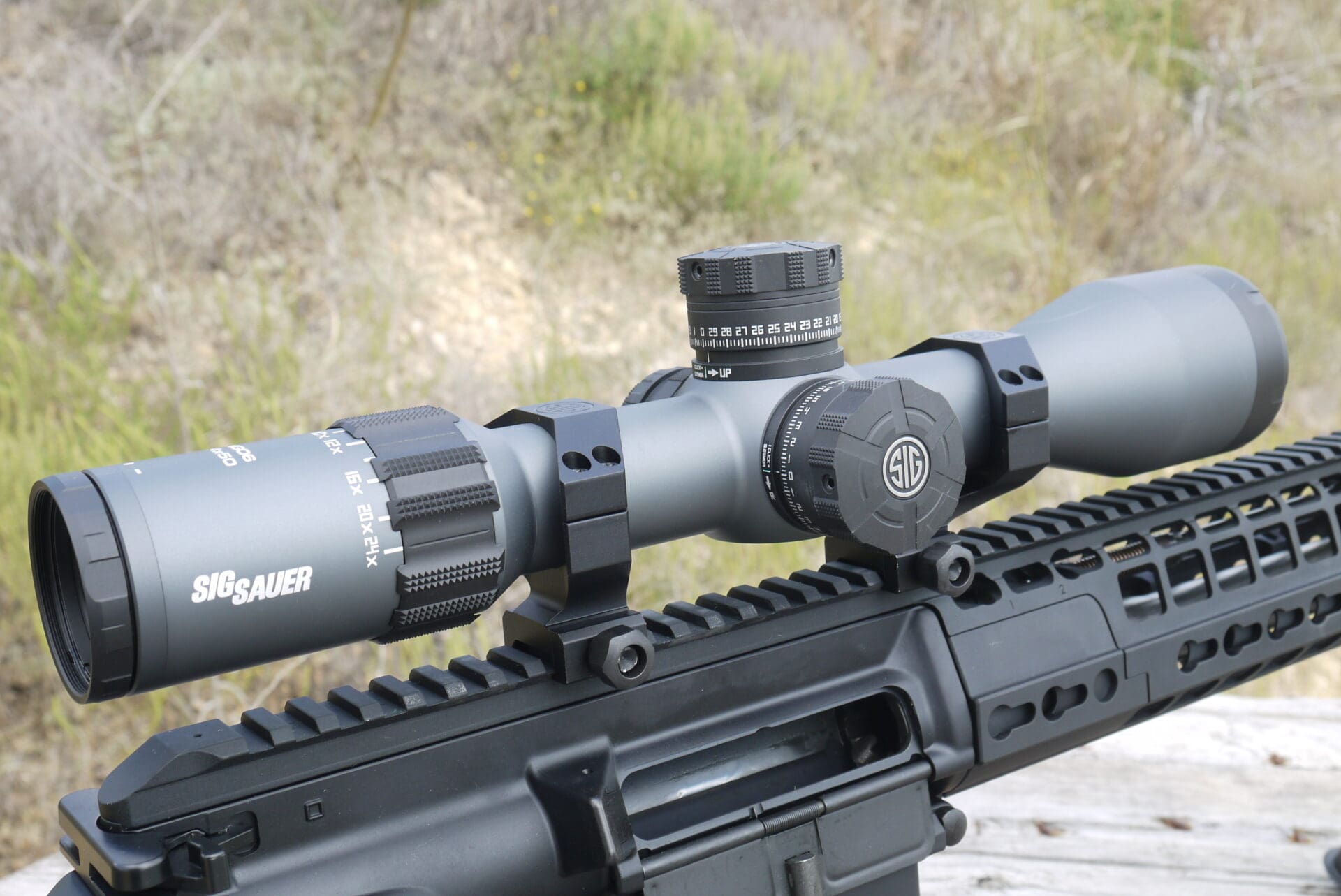
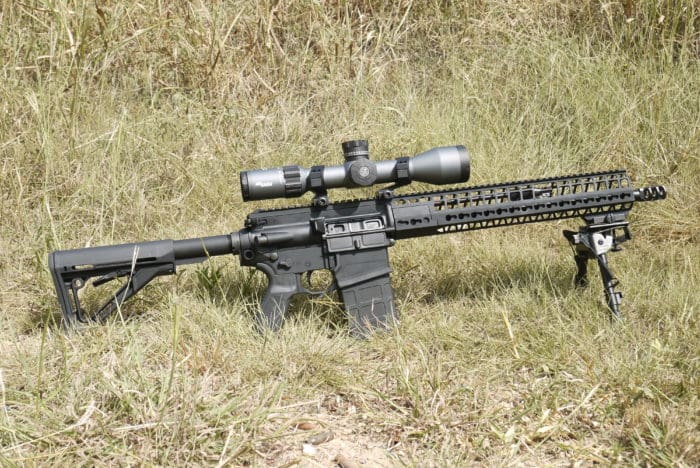
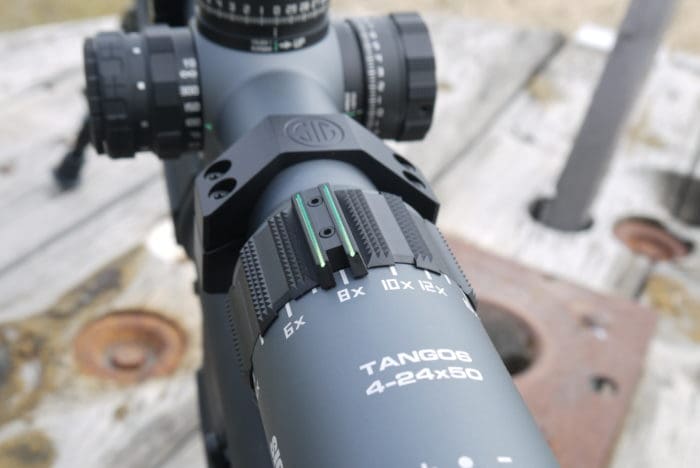
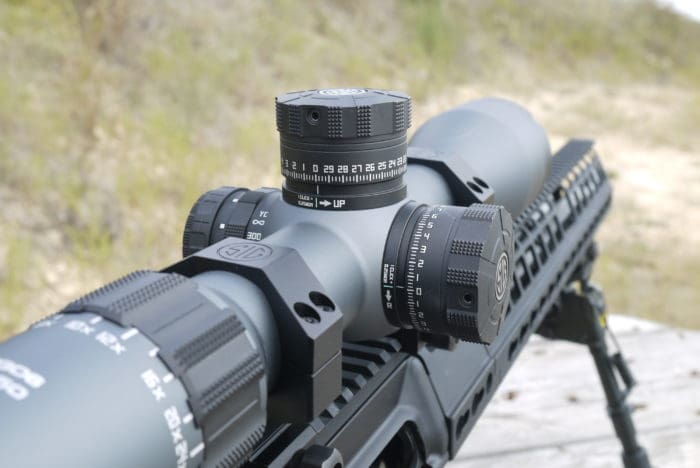
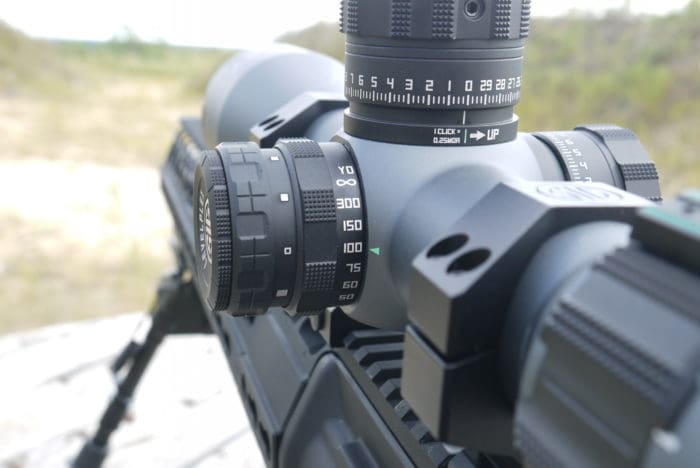
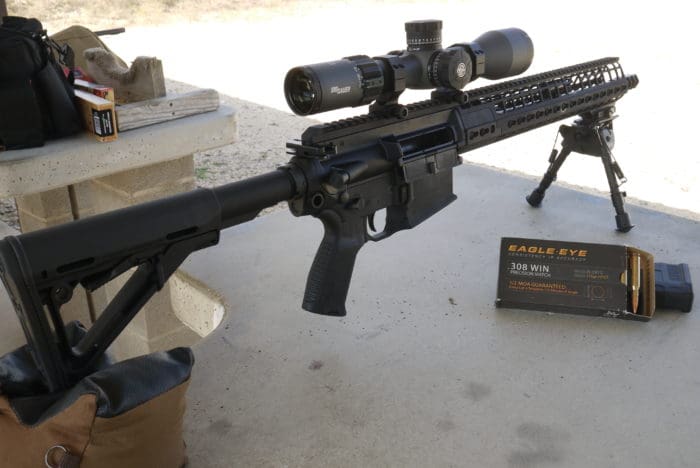
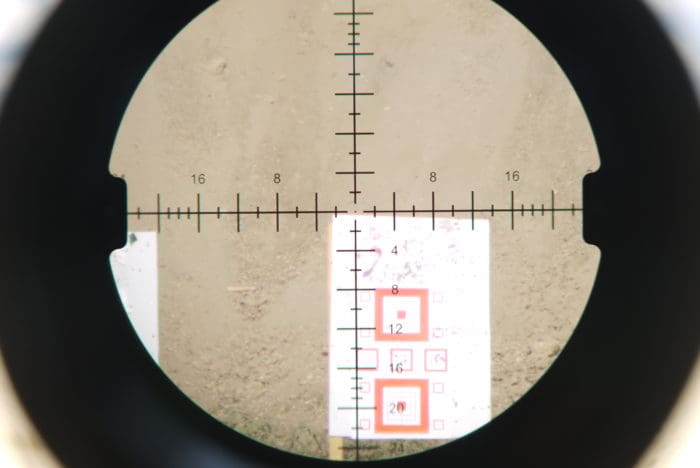
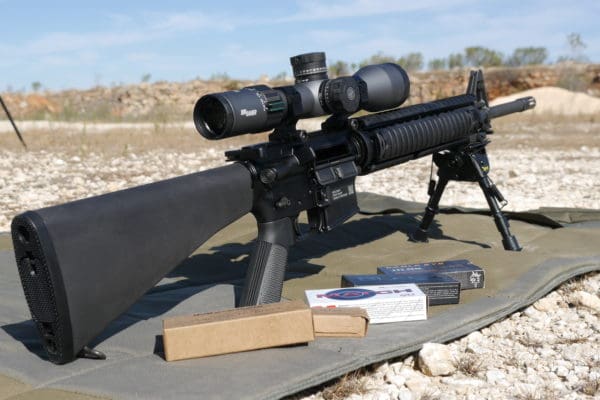



It’s not even remotely important compared to all that you covered, but I like that color. I have an m400 from years ago that’s always run like a champ. And my SRD762TI-QD is everything I ever dreamed. Sig is still solid in my book.
$2,700 ??? on sale for only $2,200… Really Guys???? WTF.
Something not in order?
It costs more than a Nightforce scope and how much benefit are you really getting? A $150 scope puts rounds on target just as well as a $1,500 scope.
Maybe. It largely depends on how fast you can bust out the math involved. This is an ffp design, which are always expensive, no matter the brand. But ffp can trim down some of that math, compared to if you’re not at the highest magnification on an sfp scope.
ARC,
hillbillyjew is correct, but too polite to my mind. Depending on application, the $150.00 scope may keep up with the $1500.00 scope, for a while-or not.
Quality cost money. Cheap stuff tends to fall apart when it is least convenient. If SHTF, I don’t want to trust my life to something that is likely to fail, sooner rather than later.
I learned a while back that buying once and crying once is a lot easier on the wallet and tear ducts than doing it over and over again.
Hahhahaha but how many $150 scopes can withstand heavy recoil operations (i.e. any 308 battle rifle) for any extended amount of the time, or in field use.
I’ll tell you…none. The military tends to go with the cheapest, bestest thing they can. There’s still a reason Schmidt and bender, Leopold, aimpoint, zeiss and trijicon reign supreme with most militaries including ours. They work, hold zero, mostly idiot proof, and hold up while being roughed up. A $150 optic may suite you well if you punch paper a few times a year, or bring out a deer rifle a time or two but if you spend weeks or months in the field, or use an FAL or G3, you’re going to kill an inferior optic. Without question…ask me how I know.
That’s a real peach of a scope. If I had the money.
In the ratings, Nick says it’s a mil scope. Pictures indicate it’s MOA. Unless Sig has figured out a way to get 23 mils of elevation on one revolution, something is amiss. Same with the pic of the reticle.
What distances were shot and was the scope tested in near dark conditions?
There may be folks who don’t know what the usual tests are, so maybe a better explanation of what tests Nick did are in order? I know what a box test is, but was a tall target test done?
The scope may be fine, but this review could be better.
I would imagine they offer both mil and moa.
Hillbillyjew,
Yes, Sig offers both MIL and MOA reticles. My point was that Nick said MIL in his ratings, and the pics are of a scope with MOA. Either show the right scope, point out the fact that you had to use the pics of the wrong one, or correct the ratings to reflect that the scope was MOA.
And I’d still like to know exactly what other tests Nick performed. And if the glass is good enough to see a target just before sun up or just after sundown. Most glass these days is fine when it’s cloudy, but when it’s near dark and you can’t see the target but need to…
A four star rating with very little real information, in my opinion.
Sarge,
I don’t think Nick was tryin’ to pull a fast one on us with MOA vs. Mil. That won’t be effecting the ability to gather light, or anything important. You probably know this, but those are personal preference specs. If he’s got a good picture of an MOA scope, us MIL guys, myself included, can connect the dots. Against my better judgement, I’d like to provide another ice cream analogy. If your local ice cream shop has a picture of vanilla in the window, it’s fair to assume they’ll also have chocolate that’ll perform for your taste buds, and the scoop won’t be any smaller than it’s vanilla counterpart.
As for your request for better testing, or at least more details on the testing, I agree 100%. I’m a lover of science, and when folks in any industry “test” something out, it rarely meets my demands. If Nick could chime in give us some objective testing parameters, that would make me happy too.
But I can speak from somewhat relevant work experience on light and optics in the medical field. There most certainly are devices to measure light. A scientific approach can be taken. And I’d like to see it. But when a surgeon says his/her light source or microscope isn’t up to snuff, money starts getting spent replacing parts or entire devices until said surgeon is satisfied. Nobody comes back to him/her with a chart full of numbers saying, “This equipment is fine. Deal with it.” My point is that when folks have the kind of money to drop thousands of bucks on a scope, they’re gonna go ahead and get what suits them. And when they don’t like it anymore, they’re gonna go buy a different one.
As for your comment above, in regards to me being too polite, thank you. I’m really trying to work on contributing to conversations around here without getting anyone’s pantie’s in a bunch. It happens too easily with us gun totin’ folk, and that’s a shame. We aught to help and support each other, because we’re all on the same side, more or less. Us “glocktards” and “sig fan boys” should be able to have intelligent conversations, even when we’re getting under each others skin here and there.
hillbillyjew,
I agree with you on practically every thing you said. My complaint about the pics and the words in the rating probably stem from me being just a bit anal about my optics.
I’d rather see this review, in particular, show exactly what is being reviewed.
To use a different analogy, if I read a review that showed a picture of an AR15, but the words describing the rifle were clearly about a short barreled rifle, I’d wonder who goofed. The same applies here.
kinda wimpy lookin rings
should be wider
with more fasteners
im quite sure that the vortex viper pst would be at least as good if not better for half the price with the same lifetime warranty that sig offers
the vortex razor probably blows this thing away for the same price
its at least as likely as not that sig prices this for the leo and “sig fanboy market” knowing people just like the name and will pay whatever price
Do the rings even come with It? That’s typically a separate purchase, in my experience. I could be wrong.
I have a few vortex products. Good bang for buck. Don’t get me wrong, I can’t afford this Sig scope atm. But I do think Sig glass clarity might have an edge on vortex.
Some folks might justify the price for the features they prefer. The most important thing for me in a scope is the reticle. I’ve grown to love the Trijicon mil square reticle. It’s not as crisp and clear as my Leupold, but that reticle is easy to use, for me.
“There was a time when SIG SAUER did one thing and did it well. Those times are past. SIG SAUER now does just about everything and . . . still does it well. Over the last decade, the company’s expanded their product line to include ammunition, optics, suppressors, and even airguns.”
Sig seems to be trimming their product line in the pistol area; gone in their latest catalog is the P290 and maybe a few others I didn’t notice.
It’s a SIG,,,and we all know aTTAG loves nothing more than something labeled SIG SAUER.
I have a friend who has this scope and the electronics aren’t up to par. He killed two of them. One on a 308 and the other on a 338. Definitely not the same quality as NF, S&B, etc. (not to mention the other qualities that don’t match real high end optics like S&B, Hensolt, etc.) NF’s Japanese made optics pass very stringent testing. SIG, not so much. They’d rather replace it in the hopes that most of their customers don’t actually use their gear for anything other than the occasional range day.
3”—and provide quick-acquisition targeting at a low magnification power, but also have the ability for precise targeting at increased magnification levels. The Mod 7 1-8x28IR-H is a second focal plane scope with Riton’s German #4 Mod 1 Illuminated reticle paired with HD/ED glass, a nearly indestructible one-piece aircraft grade main tube, and is backed by Riton’s unlimited lifetime new replacement warranty. Mod 7 1-8x28IR-T (Tactical) The tactical model of the Mod 7 1-8 features the Riton Tactical Mod 1 Illuminated reticle in first focal plane. Because of the first focal plane reticle, this optic can be used on a true 1X magnification similar to a red dot-type sight—with both eyes open for quick target engagement while clearing rooms or during close-quarters combat. Where this scope and the First Focal Plane reticle offers a distinct advantage is once you increase the magnification. As the magnification increases, so does the size of the reticle. The ability to accurately engage targets and range estimate with the First Focal Plane reticle allows this scope to fit into every conceivable tactical situation. The Tactical version of the Mod7 1-8X is designed with a first focal plane reticle- allowing the scope to be used as a “red dot” at 1x but full and easy use of mil dots at range.
Comments are closed.